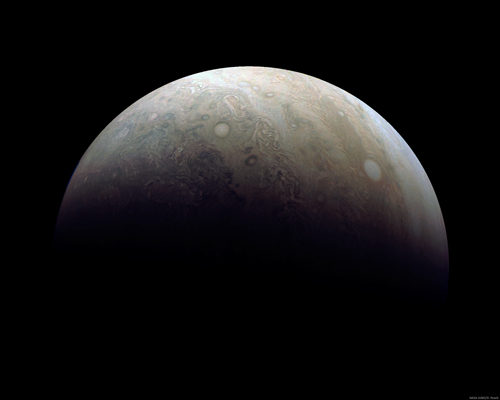This page, updated monthly, will let you know some of the things that you can look out for in the night sky. It lists the phases of the Moon, where you will see the naked-eye planets and describes some of the prominent constellations in the night sky during the month.
Highlights of the Month
31st January to 5th February - after sunset: Venus approaches within 6 degrees of Mars
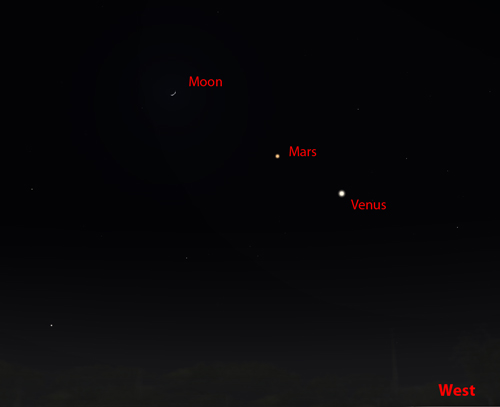
Venus comes within 6 degrees of Mars.
Image: Stellarium/IM
If clear on the evenings of the 31st of January to the 5th of February and looking southwest one could not fail to spot Venus. But, on these nights Venus comes to within 5 degrees 23 arc minutes of Mars lying up to its left. On the 31st of January and the 1st of February, they will be joined by a thin waxing crescent Moon.
5th February - all evening: The first quarter Moon occults stars within the Hyades Cluster.
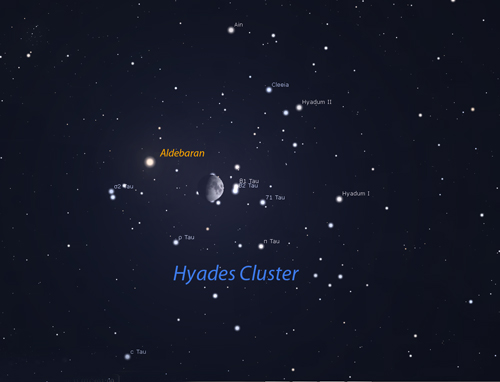
The Moon passes through the Hyades Cluster.
Image: Stellarium/IM
If clear on the evening of the 5th and looking first to the south-southeast, one will see the first quarter Moon passing in front of the Hyades cluster in Taurus. At around 18:42 its dark limb will occult the pair of stars Theta 1 and Theta 2 Tauri and at ~20:32, the magnitude 2.73 star 85 Tauri. Then at 23:27 it will lie very close to magnitude -0.7 star Aldebaran - a red giant star that lies between us and the cluster.
February 11th - just before dawn: The Full Moon below Regulus in Leo
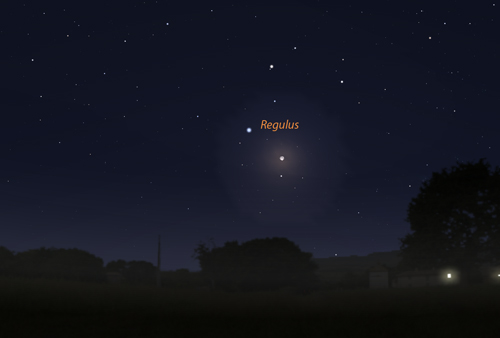
The Full Moon below Regulus in Leo
Image: Stellarium/IM
Just before dawn and, given clear skies and a very low horizon towards the west, you should easily see the Full Moon lying below the magnitude +1.35 star, Regulus, Alpha Leonis.
February 15th - before dawn: The Moon lies close to Jupiter
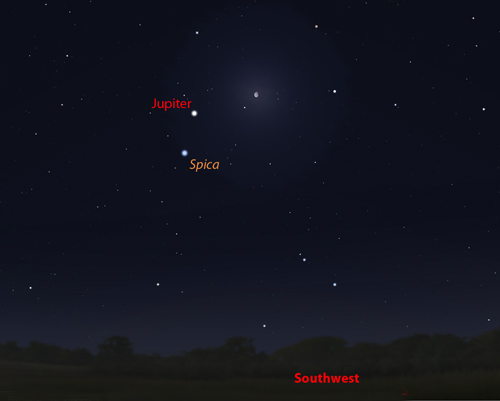
The Moon close to Jupiter
Image: Stellarium/IM
If clear before dawn on the 15th and looking southwest, one will see Jupiter lying between the Moon to its upper right and Spica, Alpha Virginis, down to its lower left.
February 21st: Saturn near a waning crescent Moon
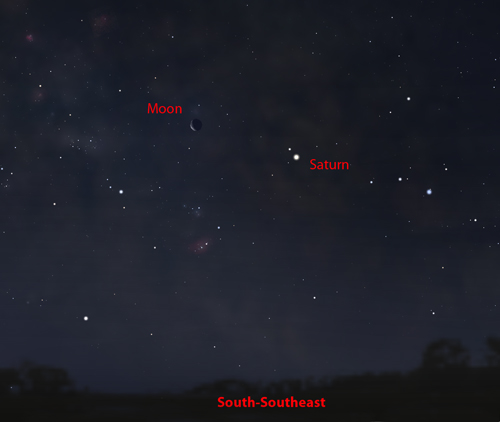
Saturn near a waning crescent Moon
Image: Stellarium/IM
Before dawn on the 21st and looking south-southeast Saturn will be seen down to the lower right of a thin waning crescent Moon.
February 26th - after sunset: Uranus close to Mars with both up to the left of Venus
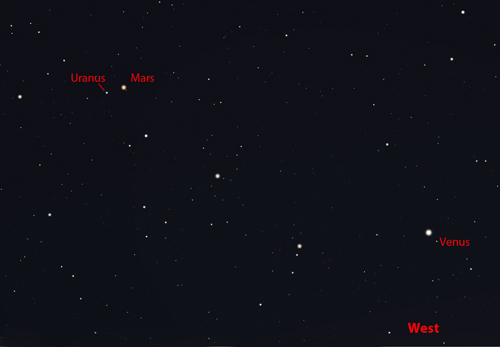
Uranus very close to Mars
Image: Stellarium/IM
This is an excellent chance to find Uranus - perhaps for the first time - shining at magnitude 5.9 just to the lower left of Mars at magnitude 1.3. They will be just 35 arc minutes apart so Uranus will be easily spotted with Binoculars. The turquoise disk with an angular size of just over 3 arc seconds may just be seen as such using a small telescope.
February 3rd and 17th evening: The Hyginus Rille
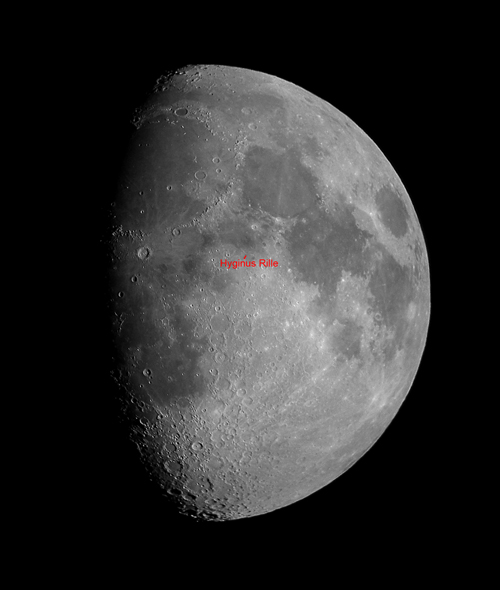
Hyginus Rille location: IM.
For some time a debate raged as to whether the craters on the Moon were caused by impacts or volcanic activity. We now know that virtually all were caused by impact, but it is thought that the Hyginus crater that lies at the centre of the Hyginus Rille may well be volcanic in origin. It is an 11 km wide rimless pit - in contast to impact craters which have raised rims - and its close association with the rille of the same name associates it with internal lunar events. It can quite easily be seen to be surrounded by dark material. It is thought that an explosive release of dust and gas created a vacant space below so that the overlying surface collapsed into it so forming the crater.
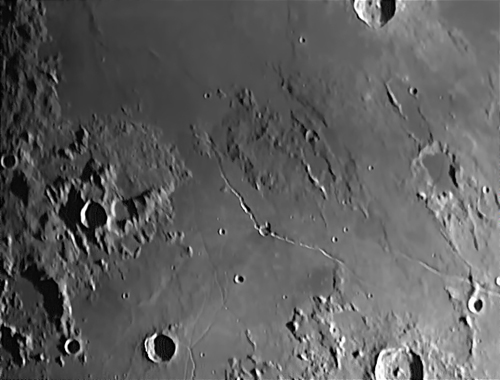
Hyginus Crater and Rille
M109 imaged with the Faulkes Telescope
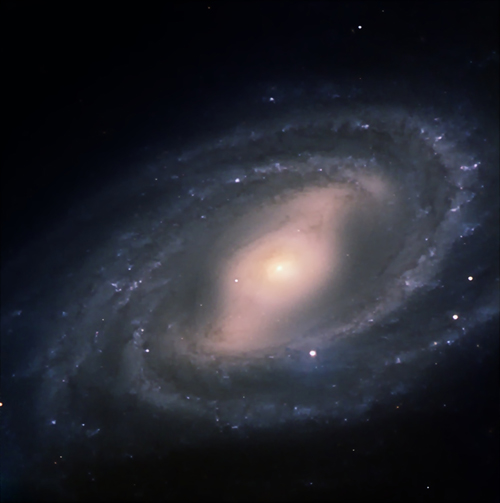
Messier 109
Image: Daniel Duggan
Faulkes Telescope North.
The Galaxy M109, imaged by Daniel Duggan.
This image was taken using the Faulkes Telescope North by Daniel Duggan - for some time a member of the Faulkes telescope team. It shows the barred spiral galaxy M109 that lies at a distance of 83 million light years in the constellation of Ursa Major. It is the brightest galaxy in the Ursa Major group of some 50 galaxies. Our own Milky Way galaxy is now thought to be a barred spiral like M109.
Learn more about the Faulkes Telescopes and how schools can use them: Faulkes Telescope"
Observe the International Space Station

The International Space Station and Jules Verne passing behind the Lovell Telescope on April 1st 2008.
Image by Andrew Greenwood
Use the link below to find when the space station will be visible in the next few days. In general, the space station can be seen either in the hour or so before dawn or the hour or so after sunset - this is because it is dark and yet the Sun is not too far below the horizon so that it can light up the space station. As the orbit only just gets up the the latitude of the UK it will usually be seen to the south, and is only visible for a minute or so at each sighting. Note that as it is in low-earth orbit the sighting details vary quite considerably across the UK. The NASA website linked to below gives details for several cities in the UK. (Across the world too for foreign visitors to this web page.)
Note: I observed the ISS three times recently and was amazed as to how bright it has become.
Find details of sighting possibilities from your location from: Location Index
See where the space station is now: Current Position
The Moon
 The Moon at 3rd Quarter. Image, by Ian Morison, taken with a 150mm Maksutov-Newtonian and Canon G7.
The Moon at 3rd Quarter. Image, by Ian Morison, taken with a 150mm Maksutov-Newtonian and Canon G7.
Just below the crator Plato seen near the top of the image is the mountain "Mons Piton". It casts a long shadow across the maria from which one can calculate its height - about 6800ft or 2250m.
| new moon |
first quarter |
full moon |
last quarter |
`
| February 26th |
February 4th |
February 11th |
February 18th |
Some Lunar Images by Ian Morison, Jodrell Bank Observatory: Lunar Images
A World Record Lunar Image
 The 9 day old Moon.
The 9 day old Moon.
To mark International Year of Astronomy, a team of British astronomers have made the largest lunar image in history and gained a place in the Guinness Book of Records! The whole image comprises 87.4 megapixels with a Moon diameter of 9550 pixels. This allows details as small as 1km across to be discerned! The superb quality of the image is shown by the detail below of Plato and the Alpine Valley. Craterlets are seen on the floor of Plato and the rille along the centre of the Alpine valley is clearly visible. The image quality is staggering! The team of Damian Peach, Pete lawrence, Dave Tyler, Bruce Kingsley, Nick Smith, Nick Howes, Trevor Little, David Mason, Mark and Lee Irvine with technical support from Ninian Boyle captured the video sequences from which 288 individual mozaic panes were produced. These were then stitched together to form the lunar image.
 Plato and the Alpine Valley.
Plato and the Alpine Valley.
Please follow the link to the Lunar World Record website and it would be really great if you could donate to Sir Patrick Moore's chosen charity to either download a full resolution image or purchase a print.
The Planets

A montage of the Solar System. JPL / Nasa
Jupiter

A Cassini image of Jupiter . Nasa
Jupiter lies in Virgo some 3 and a half degrees above its brightest star, Spica. At the start of February it rises in the east at ~00:30 but by month's end by ~22:45. It will be due south at an elevation of 34 degrees at ~06:00 at the start and at ~04:00 by the end of February. The size of Jupiter's disk increases slightly from 39 to 42 arc seconds as February progresses with its magnitude increasing very slightly from -2.1 to -2.3. On February 6th, Jupiter halts its eastwards movement across the heavens and begins to move westwards in retrograde motion for several months. With a small telescope one should be easily able to see the equatorial bands in the atmosphere, sometimes the Great Red Spot and up to four of the Gallilean moons as they weave their way around it.
See highlight above.
Saturn

The planet Saturn. Cassini - Nasa
Saturn is now a morning object, rising in the south-east at ~08:00 UT as the month begin but by about 06:30 UT at its end. Lying in the southern part of Ophiuchus, its diameter increases from 15.6 to 16.1 arc seconds during the month as it shines at magnitude +0.5. Towards the end of the month it will be high enough in the south-east before dawn to make out the beautiful ring system which, at over 26 degrees to the line of sight, are as open as they ever become. If only it were higher in the ecliptic; its elevation this year will never gets above ~18 degrees in elevation and so the atmosphere will hinder our view of this most beautiful planet. [Note: I have just acquired a ZWO Atmospheric Dispersion Corrector which uses two contra-rotating prisms to combat the dispersion of the atmosphere at low elevations.]
See highlight above.
Mercury

Messenger image of Mercury Nasa
Mercury, lies low in the southeast just before dawn down to the lower left of Saturn. It brightens from -0.2 to -1.2 during the month. It will be best seen around mid-month but no details would be expected to be seen on its disk which spans around 5 arc seconds across.
Mars

A Hubble Space Telescope image of Mars.
Jim Bell et al. AURA / STScI / Nasa
Mars is easy to find this month lying in Pisces up and to the left of Venus. They are closest on February 1st with a separation of 5.4 degrees. By month's end, as Mars continues to move eastwards and Venus begins to fall back towards the western horizon, their separation increases to just over 12 degrees. Its brightness falls slightly from magnitude +1.1 to +1.3 whilst its angular diameter falls from 5.1 to 4.6 arc seconds. No details would be expected to be seen on its salmon-pink surface.
See highlight above.
Venus

Venus showing some cloud structure
Venus is dominating the western sky this month shining virtually at its brightest with a magnitude -4.8. Its close proximity to a crescent Moon last month was given a lot of attention! It lies due south in mid-afternoon and can even by seen with the unaided eye. After dark in a very dark location it can even form shadows! On the 4th of February it reaches its highest elevation of 33 degrees at sunset. Its angular size increases from 31 to 46 arc seconds during the month but at the same time the phase reduces from 40% to 18% illuminated. These two effects compensate each other which is why the brightness stays so constant. In visible light no details are seen on its brilliant white surface but cloud details can be seen or imaged in the ultra-violet. In daytime when still high in the sky it can be imaged in the infrared as the blue light from the sky is filtered out. This month's astronomy digest article on imaging the Moon and planets in the infrared shows how Venus looked on the 5th of January 2017.
See highlight above.

Radar image showing surface features
Find more planetary images and details about the Solar System: The Solar System
The Mid Evening February Sky
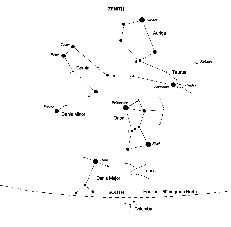
The February Sky in the south-east - mid evening.
This map shows the constellations seen in the south during the evening. The brilliant constellation of Orion is seen in the south. Moving up and to the right - following the line of the three stars of Orion's belt - brings one to Taurus; the head of the bull being outlined by the V-shaped cluster called the Hyades with its eye delineated by the orange red star Aldebaran. Further up to the right lies the Pleaides Cluster. Towards the zenith from Taurus lies the constellation Auriga, whose brightest star Capella will be nearly overhead. To the upper left of Orion lie the heavenly twins, or Gemini, their heads indicated by the two bright stars Castor and Pollux. Down to the lower left of Orion lies the brightest star in the northern sky, Sirius, in the consteallation Canis Major. Up and to the left of Sirius is Procyon in Canis Minor. Rising in the East is the constellation of Leo, the Lion, with the planet Saturn up and to the right of Regulus its brightest star. Continuing in this direction towards Gemini is the faint constellation of Cancer with its open cluster Praesepe (also called the Beehive Cluster),the 44th object in Messier's catalogue. On a dark night it is a nice object to observe with binoculars. There is also information about the constellation Ursa Major,seen in the north, in the constellation details below.
The constellation Taurus
 Taurus
Taurus
Taurus is one of the most beautiful constellations and you can almost imagine the Bull charging down to the left towards Orion. His face is delineated by the "V" shaped cluster of stars called the Hyades, his eye is the red giant star Aldebaran and the tips of his horns are shown by the stars beta and zeta Tauri. Although alpha Tauri, Aldebaran, appears to lie amongst the stars of the Hyades cluster it is, in fact, less than half their distance lying 68 light years away from us. It is around 40 times the diameter of our Sun and 100 times as bright.
 AAO Image of the Pleiades, M45, by David Malin
AAO Image of the Pleiades, M45, by David Malin
To the upper right of Taurus lies the open cluster, M45, the Pleiades. Often called the Seven Sisters, it is one of the brightest and closest open clusters. The Pleiades cluster lies at a distance of 400 light years and contains over 3000 stars. The cluster, which is about 13 light years across, is moving towards the star Betelgeuse in Orion. Surrounding the brightest stars are seen blue reflection nebulae caused by reflected light from many small carbon grains. These relfection nebulae look blue as the dust grains scatter blue light more efficiently than red. The grains form part of a molecular cloud through which the cluster is currently passing. (Or, to be more precise, did 400 years ago!)
 VLT image of the Crab Nebula
VLT image of the Crab Nebula
Close to the tip of the left hand horn lies the Crab Nebula, also called M1 as it is the first entry of Charles Messier's catalogue of nebulous objects. Lying 6500 light years from the Sun, it is the remains of a giant star that was seen to explode as a supernova in the year 1056. It may just be glimpsed with binoculars on a very clear dark night and a telescope will show it as a misty blur of light.
 Lord Rosse's drawing of M1
Lord Rosse's drawing of M1
Its name "The Crab Nebula" was given to it by the Third Earl of Rosse who observed it with the 72 inch reflector at Birr Castle in County Offaly in central Ireland. As shown in the drawing above, it appeared to him rather lile a spider crab. The 72 inch was the world's largest telelescope for many years. At the heart of the Crab Nebula is a neutron star, the result of the collapse of the original star's core. Although only around 20 km in diameter it weighs more than our Sun and is spinning 30 times a second. Its rotating magnetic field generate beams of light and radio waves which sweep across the sky. As a result, a radio telescope will pick up very regular pulses of radiation and the object is thus also known a Pulsar. Its pulses are monitored each day at Jodrell Bank with a 13m radio telescope.
The constellation Orion
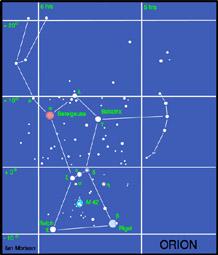 Orion
Orion
Orion, perhaps the most beautiful of constellations, will be seen in the south at around 11 - 12 pm during January. Orion is the hunter holding up a club and shield against the charge of Taurus, the Bull up and to his right. Alpha Orionis, or Betelgeuse, is a read supergiant star varying in size between three and four hundred times that of our Sun. The result is that its brightness varies somewhat. Beta Orionis, or Rigel, is a blue supergiant which, at around 1000 light years distance is about twice as far away as Betelgeuse. It has a 7th magnitude companion. The three stars of Orion's belt lie at a distance of around 1500 light years. Just below the lower left hand star lies a strip of nebulosity against which can be seen a pillar of dust in the shape of the chess-board knight. It is thus called the Horsehead Nebula. It shows up very well photographically but is exceedingly difficult to see visually - even with relativly large telescope.
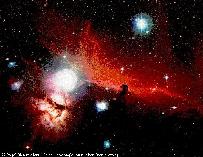 The Horsehead Nebula: Anglo Australian Observatory
The Horsehead Nebula: Anglo Australian Observatory
Beneath the central star of the belt lies Orion's sword containing one of the most beautiful sights in the heavens - The Orion Nebula. It is a region of star formation and the reddish colour seen in photographs comes from Hydrogen excited by ultraviolet emitted from the very hot young stars that make up the Trapesium which is at its heart. The nebula, cradling the trapesium stars, is a beautiful sight in binoculars or, better still, a telescope. To the eye it appears greenish, not red, as the eye is much more sensitive to the green light emitted by ionized oxygen than the reddish glow from the hydrogen atoms.
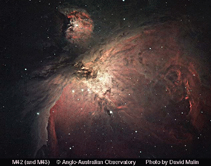 The Orion Nebula: David Malin
The Orion Nebula: David Malin
The constellation Ursa Major
 Ursa Major
Ursa Major
The stars of the Plough, shown linked by the thicker lines in the chart above, form one of the most recognised star patterns in the sky. Also called the Big Dipper, after the soup ladles used by farmer's wives in America to serve soup to the farm workers at lunchtime, it forms part of the Great Bear constellation - not quite so easy to make out! The stars Merak and Dubhe form the pointers which will lead you to the Pole Star, and hence find North. The stars Alcor and Mizar form a naked eye double which repays observation in a small telescope as Mizar is then shown to be an easily resolved double star. A fainter reddish star forms a triangle with Alcor and Mizar.
Ursa Major contains many interesting "deep sky" objects. The brightest, listed in Messier's Catalogue, are shown on the chart, but there are many fainter galaxies in the region too. In the upper right of the constellation are a pair of interacting galaxies M81 and M82 shown in the image below. M82 is undergoing a major burst of star formation and hence called a "starburst galaxy". They can be seen together using a low power eyepiece on a small telescope.
 M81 and M82
M81 and M82
Another, and very beautiful, galaxy is M101 which looks rather like a pinwheel firework, hence its other name the Pinwheel Galaxy. It was discovered in1781 and was a late entry to Messier's calalogue of nebulous objects. It is a type Sc spiral galaxy seen face on which is at a distance of about 24 million light years. Type Sc galaxies have a relativly small nucleus and open spiral arms. With an overall diameter of 170,000 light it is one of the largest spirals known (the Milky Way has a diameter of ~ 130,000 light years).
 M101 - The Ursa Major Pinwheel Galaxy
M101 - The Ursa Major Pinwheel Galaxy
Though just outside the constellation boundary, M51 lies close to Alkaid, the leftmost star of the Plough. Also called the Whirlpool Galaxy it is being deformed by the passage of the smaller galaxy on the left. This is now gravitationally captured by M51 and the two will eventually merge. M51 lies at a distance of about 37 million light years and was the first galaxy in which spiral arms were seen. It was discovered by Charles Messier in 1773 and the spiral structure was observed by Lord Rosse in 1845 using the 72" reflector at Birr Castle in Ireland - for many years the largest telescope in the world.
 M51 - The Whirlpool Galaxy
M51 - The Whirlpool Galaxy
Lying close to Merak is the planetary nebula M97 which is usually called the Owl Nebula due to its resemblance to an owl's face with two large eyes. It was first called this by Lord Rosse who drew it in 1848 - as shown in the image below right. Planetary nebulae ar the remnants of stars similar in size to our Sun. When all possible nuclear fusion processes are complete, the central core collpses down into a "white dwarf" star and the the outer parts of the star are blown off to form the surrounding nebula.

 M97 - The Owl Planetary Nebula Lord Rosse's 1848 drawing of the Owl Nebula
M97 - The Owl Planetary Nebula Lord Rosse's 1848 drawing of the Owl Nebula
